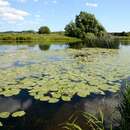Brief Summary
(
Anglèis
)
fornì da EOL authors
Nuphar, the pond-lilies, is a genus of about 10 to 12 species of aquatic flowering herbaceous plants in the Nymphaceae (water-lily family), widely distributed in temperate regions of North America, Europe, and Asia, with most species native to North America. Also called spatterdock, yellow pond-lily, cow lily, bullhead lily, water collard, and marsh collard, the genus is not as widely used for ornamental planting in water gardens as the closely related genus, Nymphaea (which is in the same family), but it does include some species and cultivars that are planted in aquariums and outdoor ponds for their beautiful submerged leaves. The rhizomes were widely used by Native Americans for food. The taxonomy of Nuphar is difficult and under revision, so the number of species is not clear. Previous classifications included as many as 26 species; later revisions reduced the number to 2, but it appears that molecular evidence supports an intermediate number. Nuphar differs from Nymphaea in floral structure. The showy parts of flowers—which are reminiscent of large buttercups—consist not of petals, but of 5–14 petal-like green to yellow sepals (to orange-red, in N. japonica), sometimes tinged with crimson or red; the petals are minute and threadlike, barely visible. The stigma is large and flattened into a disk, with 5 or more segments. Flowers are generally held 2–30 cm (1–12 inches) above the water, and fruit also develops above the water, in contrast to Nymphaea, in which the flower sinks after blooming and fruit develops submerged in water. Nuphar species generally bloom during the day. Depending on the species, leaves may be nearly round to egg-shaped to lanceolate (lance-shaped), raging in size from 8–41 cm (3–16 inches) long, and may be held above the water, floating, or submersed. Nuphar typically grows rooted in mud in shallow ponds or at the edges of lakes and slow-moving rivers or streams, in water up to 3 m (10 feet) deep. Native to Eastern North America, Nuphar species are sometimes weedy, and are now naturalized and found in all of the U.S. except Hawaii, and in all Canadian provinces. Native Americans used Nuphar rhizomes as a boiled or roasted vegetable, or dried and ground into flour. Seeds were eaten raw, ground into flour, or popped. Tea made from the roots was used to treat diarrhea, and a poultice from the roots was used to treat inflammation, boils, and tumors. (Bailey et al. 1976, Everett 1981, FNA 2011, Moermann 2003, PFAF 2011, Slocum 2005, USDA/NRCS 2011)
- licensa
- cc-by-nc
- drit d'autor
- Jacqueline Courteau

